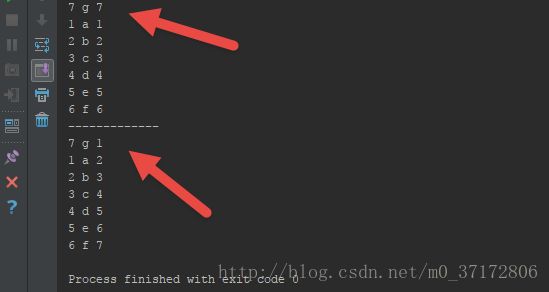java实现列表的上下移动和置顶操作
一、上下移动
1、在数据库表中新添加一列名为sort,初始值与各条数据的id相同,初始list排序按照sort的值排序。
2、思路是向上移动的时候,查询出当前数据的上一条数据的sort值,两者交换sort值,同理向下移动的时候,查询出下一条数据的sort值,两者交换。
3、ssm框架中的sql及代码实现
1) sql
<select id="infoBySortUp" parameterType="Map" resultType="com.loan.entity.WExcellentCourseEntity">
SELECT * from w_excellent_course c WHERE c.sort < #{sort} ORDER BY c.sort DESC limit 0,1
select>
<select id="infoBySortDown" parameterType="Map" resultType="com.loan.entity.WExcellentCourseEntity">
SELECT * from w_excellent_course c WHERE c.sort > #{sort} ORDER BY c.sort limit 0,1
select>
<select id="infoBySort" parameterType="Map" resultType="com.loan.entity.WExcellentCourseEntity">
SELECT * from w_excellent_course where sort=#{sort}
select>
"updateBySort" parameterType="Map">
UPDATE w_excellent_course SET sort=#{sort} WHERE id=#{id}
2) service
public WExcellentCourseEntity sortUp(String sort);
public WExcellentCourseEntity sortDown(String sort);
public WExcellentCourseEntity infoBySort(String sort);
public void updateBySort(int sort, int id);3) controller
@RequestMapping(value = "/courseSortUpdate",method = RequestMethod.GET,produces = {"text/html;charset=UTF-8"})
public String courseSortUpdate(HttpServletRequest request){
String sort=request.getParameter("sort");
String sort1=sort.substring(0,6);
WExcellentCourseEntity entity=courseService.infoBySort(sort1);
if(sort.substring(sort.length()-1).equals("1")){
WExcellentCourseEntity entity1=courseService.sortUp(sort1); courseService.updateBySort(entity1.getSort(),entity.getId());
courseService.updateBySort(Integer.parseInt(sort1),entity1.getId());
}
if(sort.substring(sort.length()-1).equals("2")){
WExcellentCourseEntity entity2=courseService.sortDown(sort1);
courseService.updateBySort(entity2.getSort(),entity.getId());
courseService.updateBySort(Integer.parseInt(sort1),entity2.getId());
}
return "operation/ecList";
}4)页面js
5) 相应位置
type="button" class="up" οnclick="changeSort(${course.sort}+'1')" value="↑"/>
type="button" class="down" οnclick="changeSort(${course.sort}+'2')" value="↓"/>二、列表中某行的置顶操作
1、思路依然是sort值的交换,只是除了普通的交换之外,还需要list的Collections.swap()方法。
2、如下是一个简单的demo:
public class stringTest {
public static void main (String[] args){
List list=new ArrayList<>();
userTest u1=new userTest();
u1.setId(1);
u1.setName("a");
u1.setSort(1);
userTest u2=new userTest();
u2.setId(2);
u2.setName("b");
u2.setSort(2);
userTest u3=new userTest();
u3.setId(3);
u3.setName("c");
u3.setSort(3);
userTest u4=new userTest();
u4.setId(4);
u4.setName("d");
u4.setSort(4);
userTest u5=new userTest();
u5.setId(5);
u5.setName("e");
u5.setSort(5);
userTest u6=new userTest();
u6.setId(6);
u6.setName("f");
u6.setSort(6);
userTest u7=new userTest();
u7.setId(7);
u7.setName("g");
u7.setSort(7);
list.add(u1);
list.add(u2);
list.add(u3);
list.add(u4);
list.add(u5);
list.add(u6);
list.add(u7);
//1、交换list的0号数据和6号数据
swap2(list, 6, 0);
for (userTest e : list) {
System.out.println(e.getId()+" "+e.getName() + " "+e.getSort()+" ");
}
System.out.println("-------------");
//2、依次交换sort数据
for(int i=0;i<list.size()-1;i++){
int sort=list.get(i+1).getSort();
list.get(i+1).setSort(list.get(i).getSort());
list.get(i).setSort(sort);
}
for (userTest e : list) {
System.out.println(e.getId()+" "+e.getName() + " "+e.getSort()+" ");
}
}
public static void swap2(List list, int oldPosition, int newPosition) {
if (null == list) {
throw new IllegalStateException("The list can not be empty...");
}
if (oldPosition > newPosition) {
for (int i = oldPosition; i > newPosition; i--) {
Collections.swap(list, i, i - 1);
}
}
}
} 运行截图如下:

可以看到list已经按照我们所想排列。
这两个功能实现只是我个人浅薄的认识,若有更好的解决办法还望各位大神指教。